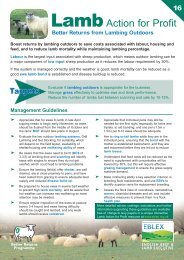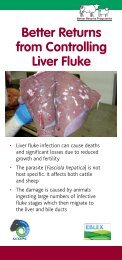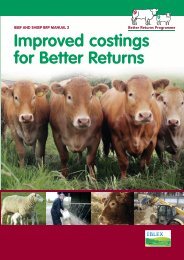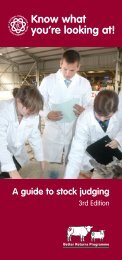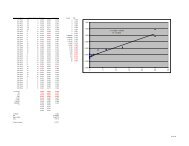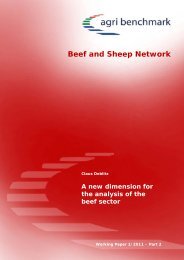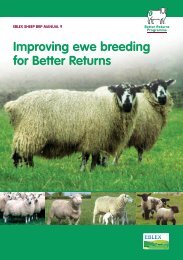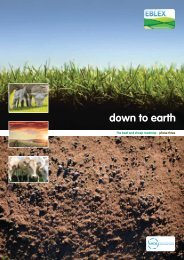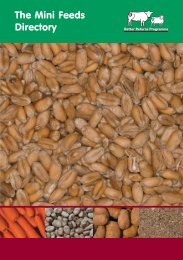Booklet - Breed a Better Pedigree Flock - Eblex
Booklet - Breed a Better Pedigree Flock - Eblex
Booklet - Breed a Better Pedigree Flock - Eblex
You also want an ePaper? Increase the reach of your titles
YUMPU automatically turns print PDFs into web optimized ePapers that Google loves.
14<br />
7.3<br />
7.4<br />
7. Measurement Services (cont)<br />
<strong>Breed</strong>ing for Gigot Muscularity<br />
<strong>Breed</strong>ers who use CT have EBVs that help identify sheep with better muscularity<br />
of the hind leg or gigot.<br />
Gigot Muscularity EBVs are produced from CT measurements of the hind leg.<br />
These measurements are positively correlated with both live weight and muscle<br />
depth measurements collected on-farm. The cost of CT scanning is currently<br />
subsidised by EBLEX for English breeders.<br />
Muscularity EBVs typically range from -5.0 to 5.0 mm and indicate how much better,<br />
or worse, an animal is relative to another. For example, a sheep with a value of 5.0<br />
will have 5 mm greater muscle thickness at a fixed bone length of 100 mm in the<br />
hind leg, than the average sheep born in 1990.<br />
<strong>Breed</strong>ing for worm resistance<br />
Internal parasite infections can reduce growth in young<br />
lambs by as much as 25% without clinical signs of infection.<br />
Lambs raise an immune response to fight worm infection<br />
and some are better at this than others. Research has<br />
identified a genetic component to worm resistance that<br />
is moderately heritable and favourably correlated to<br />
production traits, eg growth rate.<br />
Worm resistance can be improved through breeding and<br />
a commercial service is now available to assist producers<br />
in this quest through the production of FEC (Faecal Egg<br />
Count) EBVs.<br />
The number of nematode parasite eggs in dung samples<br />
is measured to provide a FEC score. This is evaluated<br />
to produce FEC EBVs.<br />
The FEC EBV identifies sheep whose genetic make-up<br />
confers resistance to nematode parasites. Low values<br />
indicate more resistance.<br />
In 2002 this Charollais reference<br />
ram had both the highest index and<br />
highest gigot muscularity EBV in<br />
the breed.<br />
Index-based selection has not been<br />
detrimental to the selection of sheep<br />
with good gigots, but the availability<br />
of an EBV for this trait will enable<br />
further improvements to be made.<br />
L<br />
Muscularity = W / L<br />
The actual gigot measures assessed on CT<br />
scans are standardised so that they represent<br />
muscle thickness (mm) at a fixed bone (femur)<br />
length of 100 mm. The typical range for these<br />
values is 40 - 80 mm.<br />
Selecting rams with highly negative<br />
FEC EBVs means the potential to:<br />
1. Perform better, eg improved growth rate<br />
2. Reduce frequency of anthelmintic treatments<br />
3. Shed fewer nematode eggs in their dung,<br />
thus reducing levels of larval challenge for<br />
other sheep (whether these have been<br />
selected for worm resistance or not)<br />
4. Reduce worm burden on heavily-stocked<br />
pastures over time<br />
<strong>Flock</strong>s that will benefit most are those:<br />
Already experiencing high levels of worm<br />
challenge<br />
Where anthelmintic use is restricted<br />
eg organic flocks<br />
<strong>Breed</strong>ing their own female replacements<br />
The cost of the FEC service is currently subsidised<br />
by EBLEX for English breeders<br />
W





